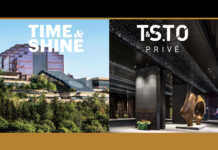
How often you should do touch-ups and when you should plan a total makeover
by Inna Levchuk
Cost is always a major driver for many businesses when undergoing renovations. In fact, for many jewellers, cost tops the list for any store renovation. Cameron Nettleton of Nettleton’s Jewellery ranked his top five important considerations for any store redesign: cost was in the top spot, followed by customer friendly displays, proper colour scheme, least inconvenience while renovating, and proper lighting. Many jewellers only have a limited budget, so major renovations can be difficult.
Leslie McGwire, president of Leslie McGwire & Associates interior design company based in Bloomfield, Michigan, who is also an award-winning designer specializing in jewellery-based businesses, says that jewellers who have a $50,000 to $100,000 budget, could have the following renovations completed with a 1,500-square-foot new or remodeled space.
- New flooring
- An updated ceiling or repaint of the existing ceiling tiles and grids, or drywall
- Paint throughout with a few accent colored walls
- New or updated decorative lighting and logo signage
- Some or all new jewellery cases, which need to look simple and clean to show off the jewelry
Changing Store Appearance
Whatever budget or square footage a jeweller is working with, McGwire says that changes should be incorporated into a store every three to five years.
“That doesn’t mean that you have to go into extremes,” explains McGwire. “The three-to-five year mark is when clients are used to the atmosphere and it’s time to show them some creativity.”
Changing the paint colours on your walls or coming up with a different wall covering from time to time is important because you want your clients to feel that your store has a cutting-edge design, says McGwire. She suggests doing more drastic changes every five to ten years, which will probably include more construction work.
“The Wow-Factor”
The mission of any business comes down to bringing the customer through their doors, and that’s where the first impression, or as McGwire puts it, “the wow-factor,” comes into play.
“You have about seven seconds to capture their attention and make them your potential customer,” she says.
McGwire believes you can achieve that by creating powerful images for your customers right from the start of their buying journey. Beautiful chandeliers and up-to-date looking jewellery cases are just the beginning.
“I think it also comes to a very nice space plan, where the customer feels comfortable, where the space can flow from one area into the other—from the diamond displays to watch areas,” she says.
According to McGwire, it’s important to create a special environment for different areas in your store. “The area of watches should be more geared towards image pictures. I like oversized light boxes or duratrans showing the individual brands. When your customers are walking around, they know: this is the watch area.”
According to Larry Johnson, the owner of Larry Johnson Consulting based in Colleyville, Texas, it’s best to allocate your showcase space based on what you want your store to specialize in.
“If you are emphasizing bridal sales, make that section of the store look the part,” he suggests. “Don’t allocate 10 per cent of your showcase space to a merchandise category that contributes five per cent of your sales.”
McGwire says it’s also important to put a lot of thought into how you are designing the POS. The counter should be conveniently located, so that the customer doesn’t have to look around to check out.
“When you are standing at the POS and you are making a purchase, that counter where you are writing your cheque and putting your purse on better be high-end—granite or beautiful glass—something special,” suggests McGwire.
Where to Start?
First of all, McGwire suggests putting together a “wish-list” with your goals, desires and needs for your entire space.
“The wish-list has everything from how many linear square feet of diamonds they need to display, how many square feet of watches they have to show, the companies that they are working with and the companies that they want to work with,” she explains. “That gives me an idea of how many jewellery cases are necessary in the space plan.”
“I suggest my clients stay with monochromatic display colours in their cases,” adds Johnson. “Too many colours in the cases make the store a patchwork quilt of colours and distract from the merchandise. I will use a contrasting colour in some cases to highlight the best pieces in each case.”
Johnson also suggests avoiding wall cases unless you have a specific idea of what merchandise you are going to place in them.
“Your customer must be able to get close to the wall case in order to buy,” he says. “Wall cases behind your showcases put your customer two to three meters away from the pieces and they will not sell unless the merchandise is very large.”
Lighting
“Great lighting is critical,” says Johnson. “It makes no sense to buy great cases and displays, fill them with beautiful goods and then not light them properly.”
“The most important is specialty lighting,” agrees McGwire. “There is nothing worse than the same lighting throughout the store with no special effect. What I recommend is that you use the correct LED (light-emitting diodes) light bulb for different areas that need to be emphasized, such as your diamond area.”
There are various lighting options currently available on the market, including gorgeous chandeliers to enhance your “wow-factor” and sconces for accent lighting.
“The other design element that I love about chandeliers is the glitter that they give off,” says McGwire. “Sconces are a beautiful touch. For example, in the diamond area, you have a beautiful sconce on the wall that coordinates with the interior. Then, you have a beautiful picture of a bride, and then, you have another sconce with another beautiful image of a bride and a groom. It’s an understated elegance.”
When it comes to lighting, such parameters as energy and cost efficiency shouldn’t be underestimated. McGwire recommends using LED lighting, which saves a lot on the electrical bill and lasts up to 50,000 hours per bulb.
“If you are on a tight budget, put up the most expensive chandelier you can afford and the most expensive specialty lighting that you can see everywhere.”
Floor Design
McGwire suggests keeping all the patterns of your floors very minimal because your customers should only be focused on your jewellery cases. She usually keeps the same flooring all the way through the store with an exception of carpeting completed behind the jewellery cases, where the jeweller stands.
McGwire says the best flooring for jewellery stores are porcelain tile, designer vinyl, cork flooring and carpeting just to name a few. Enhancing your interior, all of these options are also super low maintenance.
“I like to use carpet tiles,” says McGwire. “In case somebody spills something, you can just replace a tile, not ripping out the entire carpet.”
What’s New?
More and more trends have been evolving lately when it comes to jewellery store design.
“The newest thing that I keep hearing from clients for jewellery store design is, ‘I want to look like a Starbucks environment,’” says McGwire. “What that means is that the client doesn’t want to see a formal jewellery store like in the past.”
In order to achieve this “organic” Starbucks feel for one of her clients, McGwire went for an open space with rustic reclaimed wood floors, design cases and brick and stone walls. One unusual feature that was added to the overall design was the diamond bar with wood planks on the front of the bar, which creates the “coffee shop laid-back atmosphere”—only with diamonds on the menu.
Another inquiry that McGwire got from her client, The Diamond Center, was transforming a 12,000-square-foot jewellery store in Wisconsin into the “Apple Store look,” which meant incorporating a lot of white and grey colours, simple and clean—something untypical of a traditional jewellery store. The result was a beautiful cutting-edge design.
“The new trend that the owners want is to make people feel comfortable in their store,” says McGwire. “It’s not about that formal looking design and image that has been done for years.”
Need Help?
Before you hire a designer to help you transform your store to a jewellery haven, make sure you do your homework.
“Don’t design your store for the volume you already have, design your store to create the volume you want to achieve,” recommends Johnson. “It is like shooting ducks, you have to lead your target. Aim now for where the target will be then.”
McGwire always asks her clients to send her pictures of the jewellery stores they feel are close to their ideal image, along with their colour preferences, which sets McGwire on the right design path.
“That is so important for a designer because you could be thinking one way, and the client thinks the other way,” she says. “As a designer you have to be a great listener. You have to listen to every single thing your client says and then, you tie the design project all together. A great jewellery store designer is able to create their client’s ‘dream-come-true.’” CJ
MOODY COLOURS
To make your customers stay longer in your store, McGwire suggests neutral colours, such as brown, beige, taupe and greys, should be dominant in your design and other colours, such as reds, yellows and oranges, should be used as accents.
Also, talk to your designer about researching your preferences of colours or even build brand recognition with a specific colour. The Diamond Center opted for a modern design using white and grey colors—similar to the Apple Store.



















